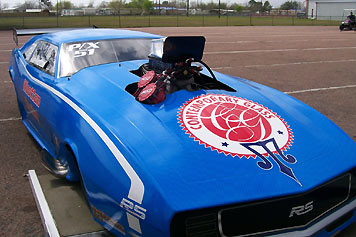THE ORIGINAL PLAN FOR PRO MOD DIDN'T INCLUDE SUPERCHARGERS OR TURBOS
 There are four power adders included in today's modern version of Pro Modified, the volatile doorslammer division launched in 1990 by the IHRA.
There are four power adders included in today's modern version of Pro Modified, the volatile doorslammer division launched in 1990 by the IHRA.
However, from the words of one of its recognized founders, the original plan only had two, and one of them was not a supercharger.
This perceived blasphemy amongst blower faithful is the contention of Ted Jones, who was the President of the IHRA when Pro Modified was announced in the fall of 1989.
Three years removed from the departure of Winston as the IHRA's primary sponsor, and a year from the Billy Meyer debacle, Jones wasn't looking for a gimmick to move the needle as much as he wanted to create his own stars within the Bristol, Tenn.-based organization.
"We wanted our own stars and our own class," Jones explained in an upcoming episode of Legends: The Series. "We had Top Sportsman, and it went over great, and here came the Charlie Carpenters and Robbie Vandegriffs and the Scotty Cannons and all these people that really made it in Top Sportsman.
"I had legalized nitrous oxide, here came Mike Thermos from NOS and he wanted to do something and he said, "Listen, why don't we have a shootout on Saturday night? I'll sponsor it. A quick eight shoot out of the top eight qualifiers."
Jones had noticed the Quick Eights in the Southeast were segregated mainly when it came to power adders. The nitrous cars ran with one another, but in some pockets allowed the blown cars to compete.
The original plan for the Quick Eights included all power adders, including turbos. Buddy Ingersoll, who once ran a V6 Buick in the IHRA's Pro Stock, was the lone wolf with a turbo-equipped Buick V6 Skyhawk.
While the turbo did little to make a ripple in the Quick Eights, a seasoned car owner named Jim Oddy with driver Fred Hahn made Jones' life, as he alluded to in not so many words, "a living hell."
Hell came to a burning crescendo when at the 1989 IHRA Fall Nationals in Bristol, Tenn. when Hahn ran a 6.69, two-tenths quicker than the quickest nitrous car had ever run.
Jones reportedly only uttered two words, "Oh, s***."
This utterance was along the line of an experience Jones had three years earlier with the decision to let Ingersoll run as a part of his previous prized creation Mountain Motor Pro Stock. Jones outlawed the turbo in Pro Stock and chalked up the experience as one mistake he'd never make again.
And with this, Jones nearly regulated the supercharged combination out of Pro Modified, with another which could have taken catching hell to another level.
It was almost too cool for words. When Don Wootton climbed out of his nitro-injected ‘69 Camaro after its maiden voyage he stopped for a moment to find the right words to say. Remember in 2009 an injected nitro doorslammer was attempted? - #DragRacingNews https://t.co/YxTkuPxhwz pic.twitter.com/7f9NYC5psW
— Competition Plus (@competitionplus) January 21, 2020
 Jones was going to replace the supercharged combination with ... injected-nitro.
Jones was going to replace the supercharged combination with ... injected-nitro.
"We had done the research," Jones revealed. "The combination had been integrated into Pro Comp and Top Alcohol Dragster, and NHRA had kept it under control."
The visions of entertainment ran wild in Jones' head.
"You could have had injected on nitromethane, and I pictured Scotty Cannon pulling to the line with the velocity stack sticking out of the hood of his Willys and the smell of nitromethane and the water in the eyes and everything.
"Then you had the nitrous guy purging his nitrous on this side, and I could see that that would be a tremendous mix. To this day, it would be cool. Put some nitromethane in there. Yes, you have to control it, but NHRA had done most of the research."
However, no one had researched to see how it would work in a doorslammer because there were none in existence, or at least that Jones was aware of.
Jones wanted to take his time and research the viability, unlike he had done with the turbo in Pro Stock. The experience scared him to death.
Jones planned to make the supercharger a placeholder until the appropriate time. Then the Hahn/Oddy 6.69 run wrecked his plan of a smooth transition.
So what did he do?
Jones, in writing the original Pro Modified rules, determined the blown combination's inclusion into the new class, would be everything the Oddy car wasn't, including a suspended chassis.
Then, as Jones plotted the course of the new class, he sold his share of the series to Carlton Phillips and a group of investors. The idea fell by the wayside as Jones left the IHRA.
Thirty years later, Jones still holds steadfast to his idea.
"It can still work, and would if NHRA or someone would give it a shot," Jones contends. "We are entertaining, and nitro is entertaining. Why not include it in a class which ranks high in entertainment value."
Travel back in time to the 1986 season, when the IHRA, then known for thinking outside of the box allowed a turbo V6 Buick to compete on its Mountain Motor Pro Stock class - #ClassicDragRacing - https://t.co/Y2wsXLZTu1 pic.twitter.com/HsyVG7XBS1
— Competition Plus (@competitionplus) January 11, 2020







































